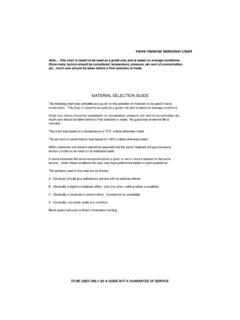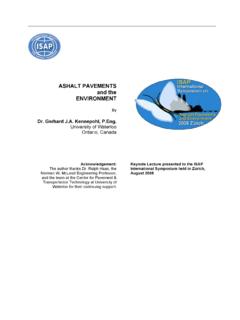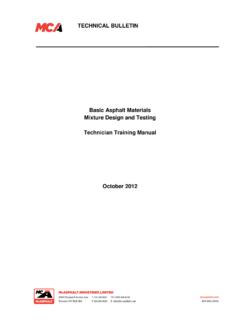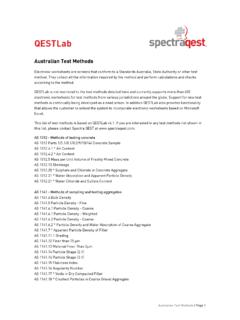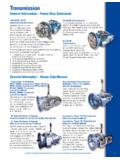Transcription of The Specification for Reinstatements of Openings in the ...
1 1 The Specification for Reinstatements of Openings in the Highway -3rdedition changes. Including a reminder of the Presentation by Enterprise2 Housekeeping Welcome and AdminTrainer Notes: Inform Operatives where the welfare facilities are located Inform Operatives where the nearest fire escape is, and who the nearest first aider is Ask Operatives to turn their mobile phones on silent throughout the duration of the course Reminder that Smoking is only allowed in designated areas3A Presentation by Enterprise3 Specification for reinstatement of Openings in the HighwayIssued in April 2010 and operational on 1 October 20104A Presentation by Enterprise4 Title here white text, Arial font 28ptMost Significant changes in SROH edition 3 Update of Asphalt Terminology in line with EN standards. Easier to follow. More use of diagrams, photos and a flow chart to make choices of permitted reinstatement options more clear. Asphalt Compaction, minor changes.
2 Minor design (layer thickness changes) in line with National Standards. Clearer diagrams for fixed features and fillets around ironwork. Amended rules on trim back to fixed features, edge preparation and sealing. Inclusion of very high amenity areas with tighter intervention criteria Wide ranging changes to App A9 use of Alternative materials to, hopefully, improve take up. App A10 PCSM s. Reworded and moved to App A2. reinstatement methods A to E rationalisedThe document is a fairly significant update but is not a complete re-write; it follows the familiar format of editions 1 & 2 while hopefully addressing many of the comments and requests received from consultees. 5A Presentation by Enterprise5 Material Descriptions-- All mixtures are now AsphaltEither Asphalt Concrete, HRA or SMAOld DescriptionNew Description0/20 Dense Macadam Binder Course 125pen AC 20 Dense Bin 100/1500/10 Close Graded Surface Course AC 10 Close Surf 100/15035% 0/14 HRA Surface Course 50 pen 65 psvHRA 35/14F Surf 40/60 65psv14mm SMA Surface Course 50pen 65 psvSMA 14 Surf 40/60 65psvUpdate of Asphalt Terminology in line with EN standardsDetails of updated EN standard terminology for asphalt mixtures, previously covered in an Advice Note, now included in the containing bitumen or tar is now called asphalt and there is potential for confusion as historically, in the UK, asphalt meant hot rolled is still HRA SMA is still SMA but the old UK term of Macadam is now replaced with Asphalt Concrete.
3 The mixtures are the same, they are name changes only. Previously the aggregate size was specified as a particle size range, for blacktop, usually 0/20 etc meaning 0 to maximum 20mm; EN asphalt standards just use the single maximum particle size as a reference. Binder Course is abbreviated to Bin and Surface Course to Surf. Binder grades are now to be referred to by the penetration range rather than the Specification mid point eg 40/60 rather than 50pen. Where polished stone value of surface course aggregate is specified then it is usual for this to form part of the material description and appear on delivery tickets but this is not a mandatory Presentation by Enterprise6 Flow chart to aid flexible reinstatement options More diagrams, flow charts and, for the first time, photographs used in an attempt to make things easier to SO1 shows a flowchart that leads through the process for blacktop selection7A Presentation by Enterprise7 Flow chart to aid flexible reinstatement options - contd Check NSG for any site specific info or construction issues Confirm Road category Identify binder course/surface course options from App Make selection and refer to A2 for mixture details.
4 Check in that exceptions don t rule out the selected surface course if they do then make another, appropriate, Presentation by Enterprise8 Edition 2 ambiguities and errors. Edge depression a trip may be at interface with existing c/way or against included ironwork. Overbanding shall be HAPAS so far there is only one. Compacted asphalt layer thickness table showed materials that weren t permitted. Much misunderstanding over what surface course material was allowed/expected where. Cleared up, hopefully, by new flow chart Some A3 Flexible Road sections indicated layer thickness for other than the default binder grade now rationalised in App A11. App A10 PCSM s incorrectly stated that PCSM s may be used in substitution for any permitted bituminous material; this has been reworded and moved to A2. A10 not used now. Other typo s and minor errors to numerous to mention. In a nutshell the asphalt choices are:Surface Courses-Existing HRA and chippings mustbe replaced with the same, wherever it occurs at the surface and it muststill be used in 0,1 and 2 roads even if the existing has been covered with a surface treatment.
5 Mixtures are 30/14 or 35/14 type F unless agreed otherwise. They mustbe design mixes in 0 and 1 roads. In 2, 3 and 4 roads designs are preferred but recipe mixes maybe used. HRA and chips maybe used in any road other than existing SMA or thin surfacing. SMA of nominal size to match the existing mustbe used wherever the existing is SMA and mustalso be used in existing thin surfacing unless the Authority asks for the thin surfacing to be replaced like for maybe used in any road other than existing Graded Surface Course maybe used in existing similar material or surface treated 3 and 4 Courses-HRA Bin, SMA Bin or AC Bin may be used in any road category or type of existing flexible construction but be careful to increase the thickness if HRA Bin is used, refer to App use of the materials hasn t really changed but by using the flowchart it should be easier to come to the correct conclusions; at least you re told where to s must have a current HAPAS certificate and will have been approved on the basis of equivalence to one of the hot lay options.
6 They may be used as interim material anywhere and as permanent material wherever the equivalent hot lay mixture is permitted in footways or type 3 or 4 Presentation by Enterprise9 Asphalt thickness requirements Design Manual for Road and Bridge Works HD 26 thickness requirements fully reflected in Type 0 and 1 roads Types 2, 3 and 4 Roads Additional thickness, up to HD 26 requirements, may be called up via A3 Notes, by the Authority where they are doing the same (Type 2 = 320mm, Type 3 = 250mm and Type 4 = 200mm, assuming use of preferred binder grade) Asphalt design thickness now reflects the preferred binder grades and also requires different thickness for HRA Bin as per HD26. HD26 design thickness for road types 2, 3 and 4 still not reflected in the Specification but where the Authority has used HD 26 on a particular road they may inform the Undertaker and require them to do the Presentation by Enterprise10 Amended rules on trim back Slight changes to trim back rules to fixed features.
7 In f/ways the feature needs to have a diameter or edge, adjacent to the reinstatement , greater than 250mm before the surface needs to be trimmed to the feature. This avoids the need to trim back to lighting columns, sign posts Presentation by Enterprise11 Trim back12A Presentation by Enterprise12 Stepped edge detail, 0 and 1 roads onlytrenchIn types 0 and 1 roads where the Authority uses a stepped edge detail they may notify and require the Utility to follow the same detail. It is limited to a maximum step of 75mm and small Reinstatements and narrow transverse trenches are Presentation by Enterprise13 reinstatement around features good practice examplesPhotos have been used to illustrate good practice eg the extent to which it is expected that modules be cut to fill in around fixed features. The photos are only in Notes for Guidance, so not a mandatory part of the code but hopefully they will reduce the amount of Presentation by Enterprise14 reinstatement around features good practice examples15A Presentation by Enterprise15 reinstatement around features good practice examplesImaginative local loss of pattern may be preferable to using small cut pieces or having a mortar Presentation by Enterprise16 Very High Amenity Areas?
8 ( ) Where an Authority is able to demonstrate that a high amenity or high duty footway has been constructed and maintained to a standard in excess of that prescribed in sections and and registered accordingly then in these circumstances the reinstatement shall meet the Authority s standard of maintenance and their declared intervention criteria .17A Presentation by Enterprise17 Asphalt compaction requirements Bituminous Materials Air Void Limits No. of Passes removed to Notes for Guidance 3 minor changes to Table (Carriageways only): AC 10 Close SC increased to 11% (from 10%) HRA SC decreased to 7% (from 8%) HRA BC decreased to 9% (from 10%) Bituminous Materials Coring Locations Anywhere in reinstatement No closer than 100mm from SU Apparatus for void testing. Asphalt compaction (air voids) test methods referred to more specifically. Now specific test methods rather than a BS standard reference which allowed various methods and interpretation.
9 This should cut down on disputes. Small increase in void content for AC 10 Surf and decrease for HRA. EN 12697 5, procedure A, in water - for maximum density measurement. EN 12697 6, for bulk density measurement (the reference to part 5 for bulk density is a typo) choice of methods for routine testing but for reference purposes or disputes procedure C, sealed specimen must be used. Notes for guidance on void testing have been Presentation by Enterprise18 Appendix A9. Alternative reinstatement Materials Aimed to improve take up of Alternative Materials Materials complying with SHW 800 series may be used as of right without trial. Other Alternative Materials need A9 trials but only once! A Highway Authority must give engineering reasons not to accept evidence from a previous trial and allow similar materials to be used. Need for Quality Control System amplifiedAlternative reinstatement Materials (ARM s) may be either:SMR- Structural Material for Reinstatements : Foamed Concrete or Hydraulically Bound in accordance with the SHW and allowed as of right or other proprietary materials that may only be used with the agreement of the Highway Authority, need an App A9 trial and are judged against the same parameters as foamed concrete and used in the same -Stabilised Material for Fill is classified as one of the classes A to D of fill material and used appropriately.
10 SMF is also likely to need an A9 need for well documented QA procedures encourages off site processes rather than mixing at the side of the road and off site production also makes it more likely that the materials can be manufactured to comply with the SHW and so not need a trial or HA Presentation by Enterprise19 Appendix A10. PCSM s Re - worded and moved to A2 A10 not now used. Materials are now to be approved as equivalent to a Hot Lay type and used as appropriate. Due to concerns over soft and unstable PCSM sthey must be capable of wet flush core sampling, to allow void testing, at 6 months from the date of permanent reinstatement . ( )Changes are to address perceived ambiguities and concerns over the use of PCSM s. The statement in A10 that Approved PCSMs, laid and compacted to App A8, may be used in substitution for any permitted bituminous material, at the discretion of the Undertaker , was misleading, it was never intended that PCSM be used in-lieu of HRA or SMA but only in place of what they were considered equivalent to.



